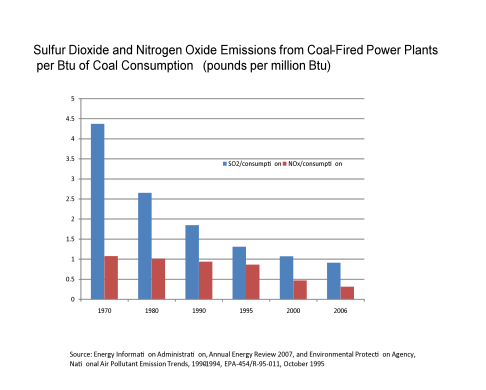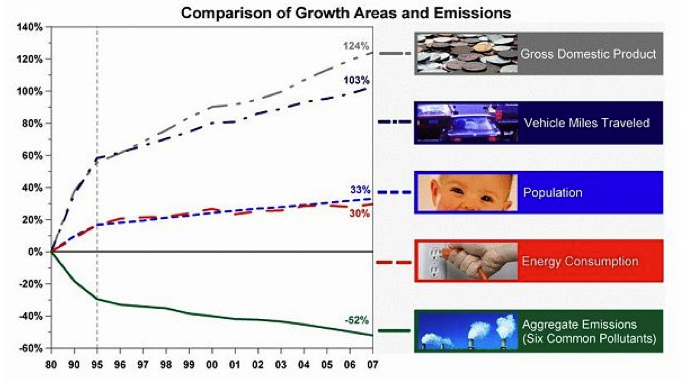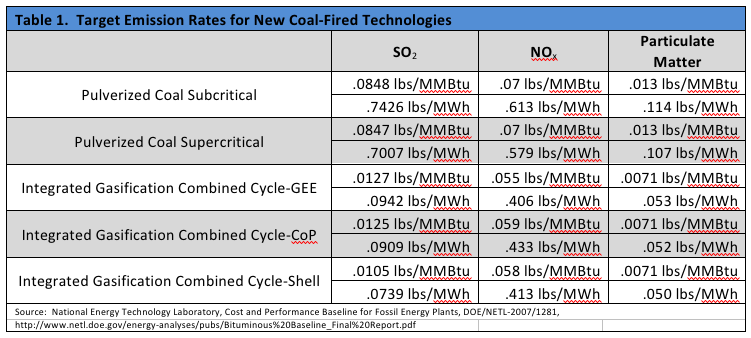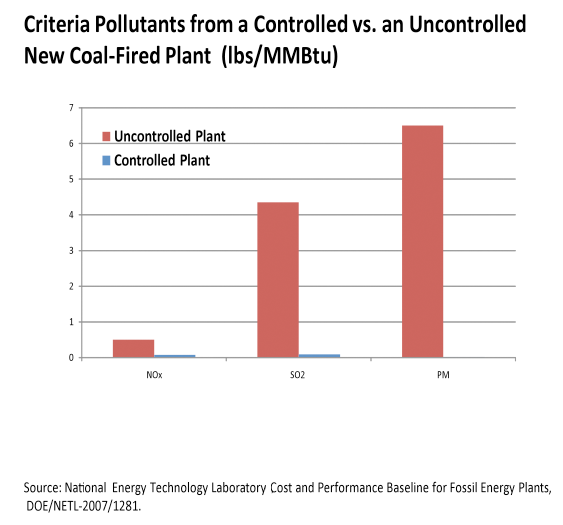Coal-fired electricity generation is far cleaner today than ever before. The popular misconception that our air quality is getting worse is wrong, as shown by EPA’s air quality data. Modern coal plants, and those retrofitted with modern technologies to reduce pollution, are a success story and are currently providing about 50% of our electricity. Undoubtedly, pollution emissions from coal-fired power plants will continue to fall as technology improves.
Executive Summary
America’s improving air quality is an untold success story. Even before Congress passed the Clean Air Act Amendments of 1970, air quality had been improving for decades.[i] And since 1970, the six so-called criteria pollutants have declined significantly, even though the generation of electricity from coal-fired plants has increased by over 180 percent. [ii] (The “criteria pollutants” are carbon monoxide, lead, sulfur dioxide [SO2], nitrogen oxides [NOx], ground-level ozone, and particulate matter [PM]. They are called “criteria” pollutants because the EPA sets the criteria for permissible levels. [iii]) Total SO2 emissions from coal-fired plants were reduced by about 40 percent between 1970 and 2006, and NOx emissions were reduced by almost 50 percent between 1980 and 2006. On an output basis, the percent reduction is even greater, with SO2 emissions (in pounds per megawatt-hour) almost 80 percent lower, and NOx emissions 70 percent lower.
Figure 1 below shows the increases in Gross Domestic Product, vehicle miles traveled, energy consumption, and population since 1980, and it compares them to the decline in the aggregate emissions of criteria pollutants. Today, we produce more energy, drive further, and live more comfortably than we did in the past, all the while enjoying a cleaner environment.
Figure 1: EPA’s Comparison of Air Quality, Emissions, and Societal Trend
Source: http://www.epa.gov/airtrends/images/comparison.jpg
One factor in improving air quality has been the pollution-control technologies used by coal-fired power plants. Today’s coal-fired electricity generating plants produce more power, with less emission of criteria pollutants, than ever before. According to the National Energy Technology Laboratory (NETL), a new pulverized coal plant (operating at lower, “subcritical” temperatures and pressures) reduces the emission of NOx by 86 percent, SO2 by 98 percent, and particulate matter (PM) by 99.8 percent, as compared with a similar plant having no pollution controls [xv]. Undoubtedly, air quality will continue to improve in the future because of improved technology.
Today, coal-fired electricity generation produces nearly half of the electricity generation in America and provides many jobs. For example, Prairie State Energy Campus, a 1,600-megawatt coal plant under construction in southern Illinois, provides 1,200 people with jobs in around-the-clock construction. Between its power plant, coal mine, and other assets, the campus will inject some $2.8 billion into the Illinois economy, creating 2,300 to 2,500 temporary construction jobs and 500 permanent positions, while emitting 80 percent less in pollutants than most existing power plants.[iv] When completed, the power plant will deliver electricity to 2.4 million homes in at least nine states.
Background
- Even before Congress passed the Clean Air Act Amendments of 1970, creating the Environmental Protection Agency, air quality was improving. Prior to 1970, business saw certain types of pollution as waste, and worked to reduce them through technological improvements in order to increase efficiency. Furthermore, state and local policymakers worked to reduce pollution.[v]
- The Clean Air Act, last modified in 1990, requires the Environmental Protection Agency (EPA) to set National Ambient Air Quality Standards to control pollutants considered harmful to public health or the environment: these are the so-called criteria pollutants.
- Two of these pollutants, SO2 and NOx are the principal pollutants that cause acid precipitation (colloquially known as acid rain). SO2 and NOx emissions react with water vapor and other chemicals in the air to form acids that fall back to earth. Prior to controlling for these emissions, power plants produced most (about two-thirds) of the SO2 emissions in the United States. The majority (about 50 percent) of NOx emissions came from cars, buses, trucks, and other forms of transportation, with power plants contributing about 25 percent. The remainder came from other sources, such as industrial and commercial boilers.[vi]
- The 1990 changes to the Clean Air Act introduced a permanent cap on the total amount of SO2 emissions that may be emitted by electric power plants nationwide, thereby reducing the level of these emissions in the atmosphere. The approach used was a cap-and-trade program with a steadily declining cap through 2010.
- In order to comply with the Clean Air Act Amendments of 1990, electric utilities could either switch to low sulfur coal, add equipment (e.g., scrubbers) to existing coal-fired power plants in order to remove SO2 emissions, purchase permits from other utilities that exceeded the reductions needed to comply with the cap, or use any other means of reducing emissions below the cap, such as operating high-sulfur units at a lower capacity utilization.
- EPA devised a two-phased strategy to cut NOx emissions from coal-fired power plants. The first phase, finalized in a rulemaking in 1995, aimed to reduce NOx emissions by over 400,000 tons per year between 1996 and 1999. The second phase began in 2000, and it aimed to reduce NOx emissions by over 2 million tons per year. The second phase reduction goal was exceeded, owing in part to additional state-initiated NOx reductions in the Northeast.[vii]
- In 1998, EPA issued a rule that required 21 states and the District of Columbia to further reduce NOx emissions through the use of newer, cleaner control strategies. The rule gave each affected state a NOx emission target and let the state determine how to reduce its emissions. The goal was to reduce total emissions of NOx by 1 million tons in the affected states by 2007. Most states were required to begin reductions in 2004.[viii]
- EPA issues air pollution control standards under the Clean Air Act Extension of 1970. These standards are called New Source Performance Standards (NSPS). EPA’s NSPS require all power plants for which construction commenced after February 28, 2005, to not exceed 1.0 lb/megawatt hour (0.11 lb/million Btu) of NOx, 1.4 lb/megawatt hour (0.15 lb/million Btu) of SO2, and 0.14 lb/megawatt hour (0.015 lb/million Btu) of particulate matter (PM). [ix] However, as can be seen below, most new plants are built to more stringent criteria.
Coal Industry Emissions Reduction
- Of the 328,720 megawatts of coal-fired capacity reporting their control technologies to the Energy Information Administration in 2005, 48 percent (158,493 megawatts) have cooling towers, 31 percent (101,338 megawatts) have flue gas desulfurization equipment (scrubbers), and 100 percent have particulate collectors.[x]
- The following graph compares the SO2 and NOx emissions from coal-fired power plants divided by the fuel consumed by these plants from 1970 to 2006. Between 1970 and 2006, SO2 emissions in lbs per million Btu were reduced by almost 80 percent and NOx emissions in lbs per million Btu were reduced by over 70 percent. Between 1970 and 2006, total SO2 emissions were reduced by about 40 percent. Between 1980 and 2006, NOx emissions were reduced by almost 50 percent.
- A study by the National Energy Technology Laboratory (NETL) compared the emission rates from pulverized coal plants and integrated gasification combined cycle plants based on the environmental regulations that would apply to plants built in 2010 using technology designs from several vendors, including General Electric Energy (GEE), ConocoPhillips (CoP), and Shell. These rates are provided in Table 1 for three criteria pollutants: sulfur dioxide, nitrogen oxides, and particulate matter (PM).[xi] The rates range from .0105 to .0848 lbs/million Btu for SO2, .055 to .07 lbs/million Btu for NOx, and .0071 to .013 lbs/million Btu for PM, depending on technology type. These emission rates are 43 to 93 percent lower than the current NSPS for SO2, 36 to 50 percent lower than the current NSPS for NOx, and 13 to 53 percent lower than the current NSPS for PM. Integrated gasification units have lower criteria pollutants than pulverized coal plants.

- According to NETL, for a new pulverized coal plant (subcritical) built in 2008, pollution controls reduce NOx emissions 86 percent, SO2 emissions by 98 percent, and PM by 99.8 percent when compared with a similar plant with no pollution controls. The target emission level for NOx is 0.070 lb/MMBtu, for SO2 is 0.085 lb/MMBtu, and for PM is 0.013 lb/MMBtu. Without control technologies, a subcritical coal plant would emit 0.5 lb/MMBtu of NOx, 4.35 lb/MM Btu of SO2, and 6.5 lb/MM Btu of PM.[xii] The figure below graphically depicts the criteria pollutants from a new controlled plant vs. a new uncontrolled plant.
Cost Factors in Emission Reductions
- According to the EIA, the costs of adding flue gas desulfurization (FGD) equipment to remove sulfur dioxide are, in 2006 dollars, $301/KW for a 300 MW plant, $230/KW for a 500 MW plant, and $190/KW for a 700 MW plant. The costs for selective catalytic reduction (SCR) equipment to remove nitrogen dioxides are $124/KW for a 300 MW plant, $108/KW for a 500 MW plant, and $98/KW for a 700 MW plant. The costs per megawatt of capacity decline with plant size. FGD units are assumed to remove 95 percent of the SO2 and SCR units are assumed to remove 90 percent of the NOx.[xiii]
- The NETL study provides estimates of both the capital cost and the levelized cost of these technologies, which are given in Table 2 in 2007 dollars.[xiv] The levelized cost is the present value of the total cost of building and operating the plant over its economic life, converted to equal annual payments. The plant costs range from $1,549 to $1,977 per kilowatt for a 550 megawatt plant, with integrated gasification combined cycle technology having the higher costs. The 20-year levelized plant cost was computed using fuel prices from the Energy Information Administration’s Annual Energy Outlook 2007. The levelized plant costs range from 6.33 to 8.05 cents per kWh.
Source: National Energy Technology Laboratory, Cost and Performance Baseline for Fossil Energy Plants, DOE/NETL-2007/1281,
http://www.netl.doe.gov/energy-analyses/pubs/Bituminous%20Baseline_Final%20Report.pdf
- NETL estimates that for a pulverized subcritical coal plant, the equipment to control NOx, SO2, and PM comprises $324/kW of the $1,549/kW plant cost (21 percent). At the request of IER, NETL estimated the cost of a subcritical pulverized coal plant without controls for criteria pollutants. The levelized cost of the new controlled plant is 6.4 cents per kWh and that of the new uncontrolled plant is 5.2 cents per kWh, 19 percent lower. A controlled plant has slightly lower output, less than 1 percent lower, and its capital costs are about 25 percent higher due to the cost of the control technologies.[xv]
Coal-fired electricity generation is far cleaner today than ever before. The popular misconception that our air quality is getting worse is wrong, as shown by EPA’s data.[xvi] Modern coal plants, and those retrofitted with modern technologies to reduce pollution, are a success story and are currently providing about 50% of our electricity. Undoubtedly, pollution emissions from coal-fired power plants will continue to fall as technology improves.
Cap-and-Trade: “Acid Rain” versus Greenhouse Gases
The results of using a cap-and-trade system to fight “acid rain” have led some to argue that it is a model for efforts to reduce carbon dioxide emissions. But the analogy fails. Stark differences exist between the “acid rain” emission-reduction program and the challenge of reducing carbon dioxide, a natural byproduct of combustion, emitted by natural and man-made sources.
Carbon dioxide is emitted in the U.S. by hundreds of millions of sources, including every personal automobile, the appliances many of us use to cook our food and heat our homes, and the businesses upon which we depend for our livelihoods, to name a few. The “acid rain” emission reduction program was initially limited to 110 site-specific utility plants, and then later expanded to 445 plants.[xvii] In addition, carbon dioxide is a world-wide byproduct of combustion, whereas all criteria pollutants are local or regional. In other words, what the United States did for SO2 and NOx directly affected air quality here, while national action to limit carbon dioxide emissions will have little bearing on aggregate global emissions.
Furthermore, at the time of the SO2 and NOx reduction program, alternative low sulfur coal sources existed and utilities had available affordable and proven technologies to utilities to reduce their emissions. When Congress passed the Clean Air Act Amendments of 1990, therefore, coal-fired utilities could responsibly reduce emissions from their plants using various options that limited cost impacts to the consumer.
In addition, attempts to extrapolate the “acid rain” success story to the challenge of reducing carbon dioxide emissions fail to recognize the history of similar programs in other parts of the world. For example, the “Emissions Trading Scheme” of the European Union has been ineffective at reducing carbon dioxide emissions at the same time it has increased prices and harmed businesses and consumers.[xviii] Further, the EU program has enriched some companies and industries at the expense of consumers.
A recent study by Laurie Williams and Allen Zabel, career employees of the Environmental Protection Agency, makes these points about what the authors call the “Acid Rain Myth.”[xix] As the authors explain, that those who champion the use of cap-and-trade to address global warming ignore the crucial distinctions between the issues we faced in 1990 with acid rain and the issues we face today with global warming.
The following highlights Williams and Zabel’s study demonstrate that the experience of the acid rain program cannot and should not be compared to cap and trade for greenhouse gas emissions:
- “Most importantly, the success of the Acid Rain program did not depend on replacing the vast majority of our existing energy infrastructure with new infrastructure in a relatively short time. Nor did it depend on spurring major innovation. Rather, the Acid Rain program was successful as a mechanism to guide existing facilities to undertake a fuel switch to a readily available substitute, the low sulfur coal in Wyoming’s Powder River Basin.”
- “The goal of the Acid Rain program was to reduce sulfur dioxide emissions, while keeping the cost of energy from coal low. To be effective, climate change legislation must do the opposite; it must gradually increase the relative price of energy from coal and other fossil fuels to create the appropriate incentives for both conservation and the scale-up of clean energy.”
- “Further, the Acid Rain program did not allow any outside offsets and so provides no basis for the widespread assumption that an offset program will help with climate change. In addition, the success of the program was aided by the low, competitive price of low-sulfur coal.”
- “According to Professor Don Munton, author of ‘Dispelling the Myths of the Acid Rain Story’ the impact of the program has been overstated: The potential for a massive switch to low sulfur coal was no secret. Such coal was cheap and available, and it became cheaper and more available throughout the 1980s. Indeed, low-sulfur coal became very competitive with high-sulfur supplied well before the Clean Air Act became law.”
In short, the mechanisms available to reduce pollutants allowed for more generation of energy with less pollution. But this success cannot be extrapolated to the regulation and reduction of carbon dioxide, a much more challenging undertaking. None of the conditions existing at the time of the apparent success of the SO2 and NOx reduction program apply to carbon dioxide, and, in any case, unilateral action by the United States will have little impact upon global carbon dioxide concentrations. Indeed, the challenges presented by the control and regulation of carbon dioxide have no parallels in the history of emission regulation.
[i] See Joel M. Schwartz & Steven F. Hayward, Air Quality in America p. 13–38 (2007). [ii] Ibid., p. 52. [iii] Environmental Protection Agency, http://www.epa.gov/air/criteria.html [iv] A Model for Coal Generation, http://energycentral.fileburst.com/EnergyBizOnline/2009-1-jan-feb/FA_Model_Coal.pdf [v] For more information, see Joel M. Schwartz & Steven F. Hayward, Air Quality in America p. 13–38 (2007). [vi] Environmental Protection Agency, http://www.epa.gov/air/caa/peg/acidrain.html [vii] Environmental Protection Agency, http://www.epa.gov/air/urbanair/nox/effrt.html [viii] Ibid. [ix] Federal Register, June 13, 2007, pages 32725, 32726, 32728, http://edocket.access.gpo.gov/2007/pdf/E7-7673.pdf [x] Energy Information Administration, Annual Energy Review 2007, Table 12.8, http://www.eia.doe.gov/aer.
[xi] National Energy Technology Laboratory, Cost and Performance Baseline for Fossil Energy Plants, DOE/NETL-2007/1281,
http://www.netl.doe.gov/energy-analyses/pubs/Bituminous%20Baseline_Final%20Report.pdf
[xii] Ibid.
[xiii] Energy Information Administration, Assumptions to the Annual Energy Outlook 2008, Table 44, http://www.eia.doe.gov/oiaf/aeo/assumption/electricity.html
[xiv]Ibid.
[xv] Email from J. Kukielka ,NETL to M. Hutzler, IER, January 9, 2009.
[xvi] Environmental Protection Agency, Air Trends, http://www.epa.gov/airtrends/.
[xvii] Kenneth P. Green et. al, Climate Change: Caps vs. Taxes, American Enterprise Institute, (June 2007) http://www.aei.org/publications/filter.all,pubID.26286/pub_detail.asp
[xviii] See European Union, Emissions trading: 2007 verified emissions from EU ETS businesses, May 23, 2008, http://europa.eu/rapid/pressReleasesAction.do?reference=IP/08/787&format=HTML&aged=0&language=EN&guiLanguage=en
[xix] Keeping Our Eyes on the Wrong Ball, 2/21/09, http://www.carbonfees.org/home/Cap-and-TradeVsCarbonFees.pdf








